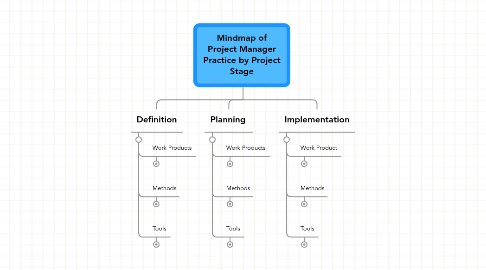
1. Definition
1.1. Work Products
1.1.1. Stakeholder Model
1.1.2. Communication Plan
1.1.2.1. Stakeholder Influence Strategy
1.1.3. Organization Model
1.1.4. Project Model
1.1.5. Change Control Plan
1.2. Methods
1.2.1. Lead Collaborative Systems Work
1.2.2. Identify Stakeholders
1.2.3. Analyze Stakeholders
1.2.4. Analyze Media and Collaboration Platforms
1.2.5. Select Media and Collaboration Platform
1.2.6. Assign Responsibilities
1.3. Tools
1.3.1. Collaboration Platform
1.3.2. Models of Human Activity System
1.3.3. Mindmapping Software/Wiki
1.3.4. Stakeholder Matrix
1.3.5. SWOT Models
1.3.6. Workflow Models
2. Planning
2.1. Work Products
2.1.1. Project Management Plan (PM Plan)
2.1.1.1. Risk Management Plan
2.1.1.1.1. Risk Model
2.1.1.2. Scope Model
2.1.1.2.1. WBS Documentation
2.1.1.2.2. Work Breakdown Structure (WBS)
2.1.1.2.3. Scope Statement
2.1.1.3. Project Schedule
2.1.1.3.1. Task List
2.1.1.3.2. Task Network
2.1.1.3.3. Task Duration Estimates
2.1.1.3.4. Critical Path (Path Duration Estimates)
2.1.1.3.5. Task Cost Estimates
2.1.1.4. Quality Plan
2.1.1.5. Purchasing Plan
2.1.1.6. Human Resources Plan
2.1.1.7. Project Budget
2.2. Methods
2.2.1. Lead Collaborative Systems Work
2.2.2. Risk Identification Methods
2.2.3. Decompose Major Deliverables into Work Packages
2.2.4. Configuration Planning Methods
2.2.5. Decompose Work Packages into Tasks
2.2.6. Precedence Diagraming Method (PDM)
2.2.7. Use CPM (Critical Path Methodology)
2.2.8. Bottom Up Estimating
2.2.9. Supplier Bid Analysis
2.2.10. Make or Buy Analysis
2.2.11. Analyze Schedule Network
2.2.12. Level Resources
2.2.13. Compress Schedule
2.2.14. Aggregate Costs
2.2.15. Analyze Reserves
2.2.16. Network
2.2.17. Reestimate the project
2.2.18. Leverage schedule float
2.2.19. Add Resources
2.2.20. Negotiate
2.2.21. Reconcile Budget with Funding Limit
2.3. Tools
2.3.1. Collaboration Platform
2.3.2. Mindmapping Software/Wiki
2.3.3. Project Management Software
2.3.4. Ishikawa Toolset
2.3.5. Organization Charts
2.3.6. Role Descriptions
2.3.7. Workflow Models
2.3.8. Contract Types
3. Implementation
3.1. Work Product
3.1.1. Deliverables
3.1.2. Quality Control Measurements
3.1.3. Validated Deliverables
3.1.4. Accepted Deliverables
3.1.5. Project Team Assignments
3.1.6. Selected Sellers
3.1.7. Contract Awards
3.1.8. Resource Calendars
3.1.9. Task Performance Information
3.1.10. Team Performance Assessments
3.1.11. Performance Measurements
3.1.12. Performance Reports
3.1.13. Forecasts
3.1.14. Change Requests
3.1.15. Change Request Decisions
3.1.16. Updates to Project Models
3.1.17. Updates to Project Plans
3.1.18. Updates to Project Records
3.1.19. Closed Contracts
3.1.20. Organization Resources
3.2. Methods
3.2.1. Lead Collaborative Systems Work
3.2.2. Acquire Project Team
3.2.3. Listen
3.2.4. Talk 1:1
3.2.5. Facilitate Meetings
3.2.6. Recognize and Reward
3.2.7. Handle Conflict
3.2.8. Engage Communities of Practice
3.2.9. Inspect Deliverables
3.2.10. Statistical Sampling
3.2.11. Pre-assignment
3.2.12. Review Approved Change Requests
3.2.13. Training
3.2.14. Modern Quality Methods
3.2.15. Quality Audits
3.2.16. Analyze Variance and Trends
3.2.17. Search Internet
3.2.18. Hold Bidder Conferences
3.2.19. Advertise
3.2.20. Proposal Evaluation Techniques
3.2.21. Purchasing Negotiations
3.2.22. Analyze Variance and Trends
3.2.23. Process Analysis
3.2.24. Earned Value Management (EVM)
3.2.25. Performance Reviews
3.2.26. Forecasting Methods
3.2.27. Analyze Variance
3.2.28. Implement Risk Responses
3.2.29. Level Resources
3.2.30. Review Approved Change Requests
3.2.31. Negotiate Settlements
3.3. Tools
3.3.1. Compress Schedule
3.3.2. Collaboration Platform
3.3.3. Virtual Teams
3.3.4. Co-location
3.3.5. Independent estimates
3.3.6. Issues Log
3.3.7. Purchasing Audits
